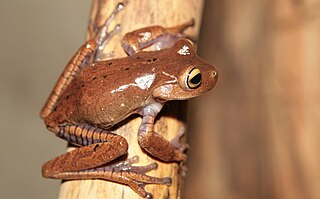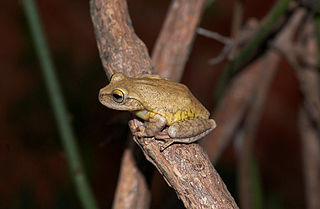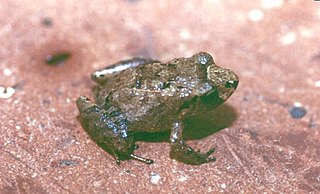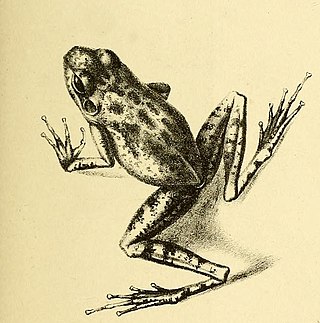
Bokermannohyla ahenea is a species of frogs in the family Hylidae. It is endemic to the Serra do Mar in São Paulo, Brazil. Its natural habitat is montane forest. While thought not to be rare, it is threatened by habitat loss caused by cattle pasture and agriculture including sugar, coffee and exotic trees. It has been recorded from the Serra da Bocaina National Park.
Bokermannohyla astartea is a species of frog in the family Hylidae. It is endemic to Brazil. Its natural habitat is subtropical or tropical moist lowland forests.
Bokermannohyla carvalhoi is a species of frog in the family Hylidae. It is endemic to Brazil. Its natural habitats are subtropical or tropical moist montane forests and rivers. It is threatened by habitat loss, due to deforestation.
Bokermannohyla gouveai is a species of frog in the family Hylidae. It is endemic to Itatiaia National Park, Brazil. Its natural habitats are subtropical or tropical moist montane forests, subtropical or tropical high-altitude shrubland, rivers, and pastureland. It is threatened by habitat loss for logging and agriculture.

Bokermannohyla ibitiguara is a species of frog in the family Hylidae. It is endemic to Alpinópolis and Serra da Canastra, Brazil. Its natural habitats are moist savanna and rivers. It is threatened by habitat loss for agriculture, human settlement, tourism and fires.

Bokermannohyla izecksohni, also known as Izecksohn's treefrog, is a species of frog in the family Hylidae. It is endemic to São Paulo state, Brazil. It was already considered possibly extinct in 2004, but three living frogs were discovered in 2005–2006. It is a medium-sized treefrog, measuring about 45 mm (1.8 in) in snout–vent length.
Bokermannohyla langei is a species of frog in the family Hylidae. It is endemic to Brazil, known only from Paraná. It is known from three specimens collected in 1953 and searches since 1986 have not found this frog. Its natural habitats are subtropical or tropical moist lowland forests, rivers, freshwater marshes, and intermittent freshwater marshes. It may be threatened by touristic activities but is protected by Parque Estadual Pico do Marumbi.

Bokermannohyla luctuosa is a species of frog in the family Hylidae. It is endemic to Brazil. Its natural habitats are subtropical or tropical moist lowland forests and rivers. It is threatened by habitat loss.

Bokermannohyla martinsi is a species of frogs in the family Hylidae. It is endemic to Brazil. Its natural habitats are moist savanna, subtropical or tropical moist shrubland, subtropical or tropical high-altitude shrubland, and rivers. It is threatened by habitat loss.

Bokermannohyla nanuzae is a species of frog in the family Hylidae. It is endemic to Brazil and known from the Serra do Espinhaço and Serra da Mantiqueira in the Minas Gerais state.

Bokermannohyla saxicola is a species of frog in the family Hylidae. It is endemic to Brazil. Its natural habitats are moist savanna, subtropical or tropical moist shrubland, subtropical or tropical high-altitude shrubland, subtropical or tropical dry lowland grassland, rivers, and intermittent rivers. It is threatened by habitat loss.
Bokermannohyla sazimai is a species of frog in the family Hylidae. It is endemic to Serra da Canastra National Park and Uberlândia, Brazil. Its natural habitats are subtropical or tropical dry forests, moist savanna, subtropical or tropical moist shrubland, subtropical or tropical high-altitude shrubland, and rivers. It is threatened by habitat loss for agriculture, logging, fires and construction of dams.

Scinax cuspidatus is a species of frog in the family Hylidae. It is endemic to Brazil. Its natural habitats are subtropical or tropical moist lowland forests, subtropical or tropical moist shrubland, subtropical or tropical dry lowland grassland, freshwater marshes, intermittent freshwater marshes, rocky areas, heavily degraded former forest, and ponds. It is threatened by habitat loss.
Ischnocnema gehrti is a species of frog in the family Brachycephalidae. It is endemic to Brazil. Its natural habitat is subtropical or tropical moist lowland forest.
Ischnocnema octavioi is a species of frog in the family Brachycephalidae. It is endemic to Brazil. Its natural habitats are subtropical or tropical moist lowland forest and subtropical or tropical moist montane forest. It is threatened by habitat loss.

Ischnocnema parva is a species of frog in the family Brachycephalidae. It is endemic to Brazil. Its natural habitat is subtropical or tropical moist lowland forest. It is threatened by habitat loss.
Euparkerella cochranae is a species of frog in the family Strabomantidae. It is endemic to Brazil. Its natural habitat is subtropical or tropical moist lowland forest. It is threatened by habitat loss.
Hylodes amnicola is a species of frog in the family Hylodidae. It is endemic to Minas Gerais in Brazil. It has been observed 1400 meters above sea level.
Hylodes babax or the Caparao Mountains tree toad is a species of frog in the family Hylodidae. It is endemic to Brazil.

Hylodes nasus is a species of frog in the family Hylodidae. It is endemic to Brazil. Its natural habitats are subtropical or tropical moist lowland forest and rivers. This frog has been observed 1400 meters above sea level.










